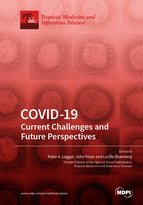COVID-19: Current Challenges and Future Perspectives
A special issue of Tropical Medicine and Infectious Disease (ISSN 2414-6366).
Deadline for manuscript submissions: closed (30 June 2021) | Viewed by 142411
Special Issue Editors
2. School of Medicine, College of Medicine, Nursing and Health Sciences, University of Galway, Galway, Ireland
Interests: neglected tropical diseases; lymphatic filariasis; dengue; malaria; occupational health; travel medicine; emerging public health threats
Special Issues, Collections and Topics in MDPI journals
Interests: parasitic and zoonotic infections; travel and tropical medicine
Special Issues, Collections and Topics in MDPI journals
Interests: one health; epidemic and pandemic preparedness and response; emerging zoonoses; malaria
Special Issues, Collections and Topics in MDPI journals
Special Issue Information
Dear Colleagues,
On March 11, 2020, the World Health Organization declared COVID-19 as a global pandemic and the disease now affects nearly every country and region. Caused by SARS-CoV-2, COVID-19 is presenting significant challenges to health systems and public health in both hemispheres, as well as the economies of each country. The morbidity and mortality of the infection caused by SARS-CoV-2 has been significant in a short period and initially overwhelmed many hospitals and clinics. It influences everyone, and countermeasures have been dramatic in their impact on employment, social systems, and mental health.
This Special Issue provides an avenue for authors from various disciplines to provide feedback on the response and our preparedness to COVID-19 globally, as well as to disseminate critical information about the SARS-CoV-2 virus and the associated COVID-19 Pandemic. We are accepting submissions from around the world, but we are particularly interested in submissions featuring perspectives from the Southern Hemisphere.
The scope of the issue shall encompass the following:
- Original articles about COVID-19 (including epidemiology, modelling, clinical data, treatment, prevention, countermeasures, impact on tropical regions, response, and preparedness)
- Original articles about SARS-CoV-2 (microbiology, virology, transmission, pathology, and vaccinology)
- Perspectives about COVID-19 and SARS-CoV-2 (comparisons with past coronavirus outbreaks, impactful local initiatives, novel responses and commentaries)
- Reviews on COVID-19 (based on systematic and narrative reviews)
- Innovations (vaccine development, drug trials, and original countermeasures)
Prof. Dr. Peter A. Leggat
Prof. Dr. John Frean
Prof. Dr. Lucille Blumberg
Guest Editors
Manuscript Submission Information
Manuscripts should be submitted online at www.mdpi.com by registering and logging in to this website. Once you are registered, click here to go to the submission form. Manuscripts can be submitted until the deadline. All submissions that pass pre-check are peer-reviewed. Accepted papers will be published continuously in the journal (as soon as accepted) and will be listed together on the special issue website. Research articles, review articles as well as short communications are invited. For planned papers, a title and short abstract (about 100 words) can be sent to the Editorial Office for announcement on this website.
Submitted manuscripts should not have been published previously, nor be under consideration for publication elsewhere (except conference proceedings papers). All manuscripts are thoroughly refereed through a single-blind peer-review process. A guide for authors and other relevant information for submission of manuscripts is available on the Instructions for Authors page. Tropical Medicine and Infectious Disease is an international peer-reviewed open access monthly journal published by MDPI.
Please visit the Instructions for Authors page before submitting a manuscript. The Article Processing Charge (APC) for publication in this open access journal is 2700 CHF (Swiss Francs). Submitted papers should be well formatted and use good English. Authors may use MDPI's English editing service prior to publication or during author revisions.
Keywords
- coronavirus
- countermeasures
- COVID-19
- Infectious disease
- microbiology
- origins
- outbreak
- pandemic
- pathology
- pneumonia
- preparedness
- psychological impacts
- public health
- response
- SARS-CoV-2
- severe respiratory distress syndrome
- social effects
- Southern Hemisphere
- tropics
- virology
- zoonosis









